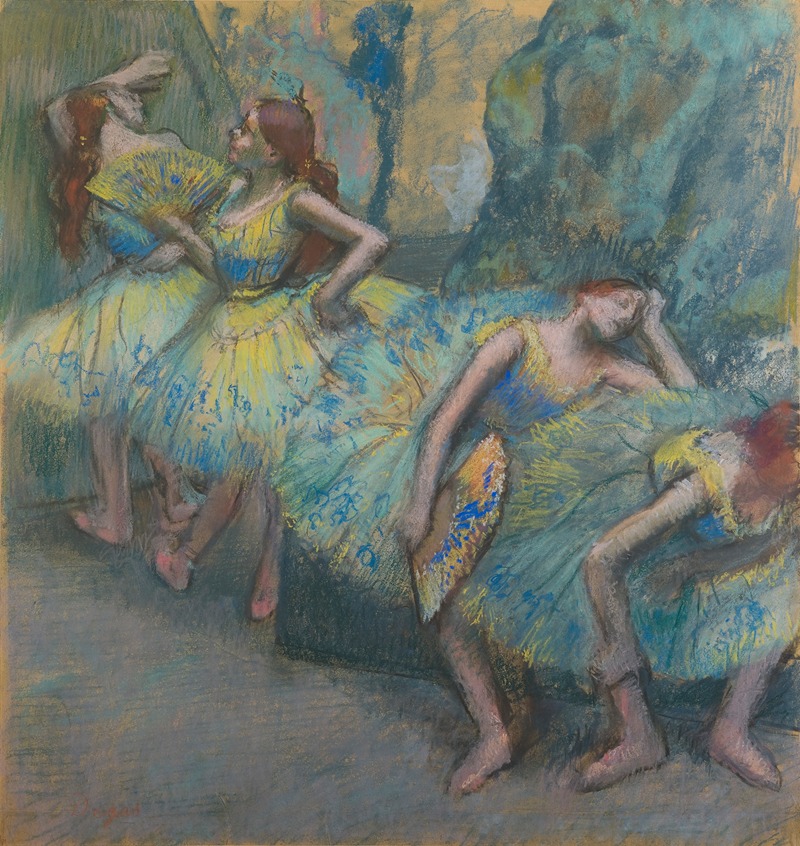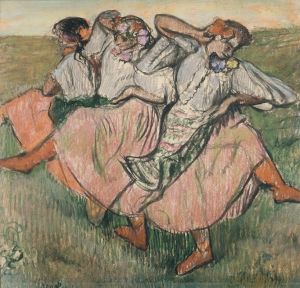
Ballet Dancers in the Wings
A hand-painted replica of Edgar Degas’s masterpiece Ballet Dancers in the Wings, meticulously crafted by professional artists to capture the true essence of the original. Each piece is created with museum-quality canvas and rare mineral pigments, carefully painted by experienced artists with delicate brushstrokes and rich, layered colors to perfectly recreate the texture of the original artwork. Unlike machine-printed reproductions, this hand-painted version brings the painting to life, infused with the artist’s emotions and skill in every stroke. Whether for personal collection or home decoration, it instantly elevates the artistic atmosphere of any space.
"Ballet Dancers in the Wings" is a painting by the renowned French artist Edgar Degas, who is celebrated for his extensive work capturing the world of ballet. Degas, a prominent figure in the Impressionist movement, was particularly fascinated by the ballet and often depicted dancers in various stages of performance and rehearsal. His works are known for their innovative compositions, use of color, and keen observation of movement and form.
This particular painting, "Ballet Dancers in the Wings," exemplifies Degas's interest in the behind-the-scenes aspects of ballet. Rather than focusing solely on the performance itself, Degas often chose to depict dancers in more candid, informal moments, such as warming up, resting, or waiting in the wings. This approach provided a more intimate and realistic portrayal of the life of a dancer, capturing the physical demands and dedication required by the art form.
Degas's technique in this painting, as in many of his works, demonstrates his mastery of both drawing and painting. He often used pastels, which allowed him to achieve a soft, delicate quality that was well-suited to the depiction of dancers. The use of pastels also enabled Degas to experiment with color and light, creating a sense of movement and atmosphere that brought his subjects to life.
The composition of "Ballet Dancers in the Wings" is notable for its dynamic arrangement and perspective. Degas frequently employed unusual angles and cropping in his work, influenced by the burgeoning field of photography and Japanese prints, which were popular in Europe at the time. This painting likely features a similar approach, with dancers positioned in a way that suggests spontaneity and naturalism, capturing a fleeting moment in time.
Degas's focus on the ballet was not merely an artistic choice but also a reflection of the cultural milieu of Paris in the late 19th century. The Paris Opera Ballet was a prestigious institution, and ballet was a popular subject among artists and the public alike. Degas's works provide valuable insight into this world, offering a glimpse into the lives of dancers and the environment in which they worked.
While specific details about "Ballet Dancers in the Wings" such as its exact date of creation or current location may not be readily available, it remains an important part of Degas's oeuvre. His ballet paintings, including this one, continue to be celebrated for their beauty, technical skill, and the unique perspective they offer on the world of dance.
Degas's legacy as an artist is firmly established, and his works are held in high esteem by art historians and enthusiasts. "Ballet Dancers in the Wings" is a testament to his enduring fascination with movement, his innovative approach to composition, and his ability to capture the grace and complexity of the human form.


















